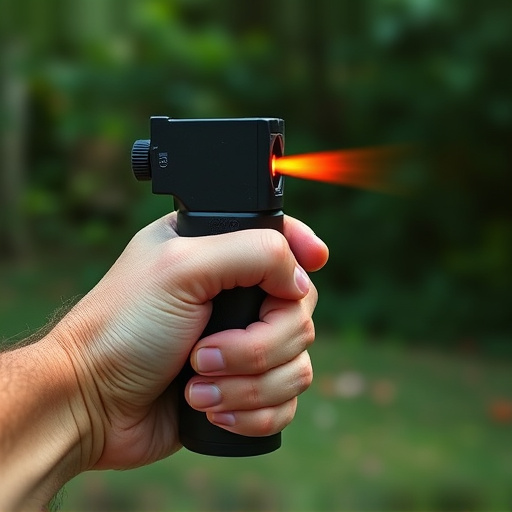TL;DR:
Pepper spray, a powerful self-defense tool, temporarily disables attackers through capsaicin exposure. Safe handling includes wearing protective gear, avoiding nozzle pointing, and immediate cleaning after use to prevent contamination. Storage should be in secure, cool, dry locations. In case of exposure, move to fresh air, remove contaminated clothing, rinse affected areas with water for 15 minutes, and seek medical attention if symptoms persist. Effective treatment involves eye flushing for at least 15 minutes and hand washing to avoid transferring the irritant. Following these steps is crucial for safely treating pepper spray exposure.
“Staying safe while carrying a pepper spray self-defense weapon is paramount. This comprehensive guide equips you with crucial knowledge on how to effectively utilize and manage this powerful tool. From understanding the intense yet temporary effects of pepper spray to learning secure handling and storage procedures, these insights are vital. Moreover, mastering proper treatment for exposure is essential when facing an attack. Discover practical tips on ‘How to Treat Pepper Spray Exposure’ and gain confidence in your personal safety.”
- Understanding Pepper Spray and Its Effects
- Safe Handling and Storage Procedures
- How to Treat Pepper Spray Exposure
Understanding Pepper Spray and Its Effects
Pepper spray, a self-defense weapon designed to incapacitate an attacker temporarily, is a powerful chemical agent. When deployed, it releases a fine mist containing capsaicin, the active ingredient found in chili peppers. This irritates the eyes, nose, and respiratory system, causing tearing, coughing, difficulty breathing, and temporary blindness. Understanding these effects is crucial for individuals aiming to use pepper spray effectively and safely.
Knowing how to treat pepper spray exposure is equally vital. If exposed, immediately wash the affected area with soap and water. For eye exposure, flush thoroughly with clean water for at least 15 minutes. Seek medical attention if symptoms persist or worsen. Wearing protective gear, such as gloves and eye protection, can also help minimize direct contact and reduce the risk of exposure during usage.
Safe Handling and Storage Procedures
Safe Handling and Storage Procedures
When handling pepper spray, always wear protective gloves and ensure your face is covered with a mask or face shield. Never point the nozzle at yourself or anyone else, even if it’s turned off—the spray can remain active for some time after use. After deployment, clean the spray device immediately with soap and water to avoid contamination and prolong its lifespan. Store pepper spray in a secure location, out of reach of children and unauthorized individuals. Use a locked storage container or a safe to prevent accidental discharge. Keep it cool, dry, and away from direct sunlight to maintain its effectiveness.
In case of exposure, how to treat pepper spray exposure is crucial. If you or someone nearby is affected, move to an area with fresh air immediately. Remove contaminated clothing and wash the affected skin areas thoroughly with soap and water. If irritation persists, seek medical attention promptly. Keep a well-stocked first aid kit handy, including eye wash solutions and any other recommended emergency supplies, to effectively manage exposure incidents.
How to Treat Pepper Spray Exposure
In the event of pepper spray exposure, the first step is to quickly move to a safe, open area away from the source. Remove any clothing or items that may have come into contact with the spray, including eye glasses and contact lenses, as these can retain the irritant. Wash affected areas with plenty of water for at least 15 minutes to dilute the pepper spray.
Seek medical attention immediately if breathing becomes difficult or if irritation persists after initial rinsing. Eye protection is crucial, as pepper spray can cause severe eye damage. If eyes are affected, hold them open and rinse slowly under running water for at least 15 minutes. Wash hands thoroughly with soap and water to prevent transferring the irritant to other parts of your body.
Pepper spray can be an effective self-defense tool, but proper handling and knowledge of treatment procedures are essential. By understanding its effects and learning how to safely store it, you can also ensure that exposure to pepper spray is effectively treated. Remember, knowing how to handle these situations can make all the difference in keeping yourself safe.
